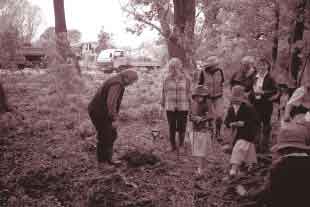| Our Environment: Issue 26 Autumn 2001 |
| In a
nutshell … The Guidelines for Environmental Education were published for the Ministry of Education in 1999, providing guidance for teachers wishing to introduce a variety of environmental programmes to their teaching. There are three dimensions, in, about and for, which describe ways in which environmental education (EE) can help learners achieve the five aims of developing awareness and sensitivity, knowledge and understanding, concerned attitudes and values, skills, and a sense of responsibility. The key concepts in EE are interdependence, sustainability, biodiversity and personal and social responsibility for action. |
Christchurch’s parks and reserves provide an exciting, accessible and relevant context for learning experiences outside the classroom.
They offer the ideal opportunity for students to be involved with learning in their local environment while learning about their environment. Through issues-based programmes they will also have an opportunity to get involved in education for their local environment through positive actions taken on site during a park visit, back at school, in their community or around their own home.
The following sites provide a great setting for students to develop their understanding of the key concepts of environmental education: Avon-Heathcote Estuary, Beach Parks (Spencer Park, South Brighton and Taylor’s Mistake), Bottle Lake Forest Park, Christchurch Botanic Gardens, Halswell Quarry Park, Port Hills Reserves, Brooklands Lagoon, Styx Mill Conservation Reserve, The Groynes and Travis Wetland Heritage Park.
Contact the Environmental Education Programme Co-ordinator, Janice Beaumont for more details by email (janice.beaumont@ccc.govt.nz) janice.beaumont@ccc.govt.nz or fax (03) 941 8987, or contact the rangers at the parks.
Here’s what one school in Christchurch is up to …
 Late last
year students from St Peter’s School in Beckenham took some positive action in their
local environment by planting over 500 native trees in the Ernle Clark Reserve. The
planting event was the culmination of their studies about the protection and restoration
of our native bush.
Late last
year students from St Peter’s School in Beckenham took some positive action in their
local environment by planting over 500 native trees in the Ernle Clark Reserve. The
planting event was the culmination of their studies about the protection and restoration
of our native bush.
The reserve has held a special place in the school’s heart for some time and last
year’s planting has created an even greater attachment to the area. One class is
undertaking a fully integrated approach to studying the environment.
As part of their studies students will visit Ernle to sketch a landscape plan of a section
of the trees planted and take base-line measurements of 20 trees to use for graphing
activities back in the classroom.
The data collected will form the basis of ongoing monitoring of the growth of the trees by
students from the school in coming years.
Students will also cover topics including the importance of our parks and reserves and the role of the park ranger, reducing our waste through composting (including a visit to the Garden City Compost facility), the value of trees to our city’s air quality (with a visit to the Botanic Gardens – the ‘lungs’ of the City) and the sustainable use of trees (with a visit to Bottle Lake Forest - a working pine forest).
| Take
some action! If your school would like to take some positive action for the environment take advantage of this great offer… Free trees for schools’ Arbor Day programmes. Register using the pack sent to all schools this month. |
Look out for these features in future issues …
| Our Environment Index |